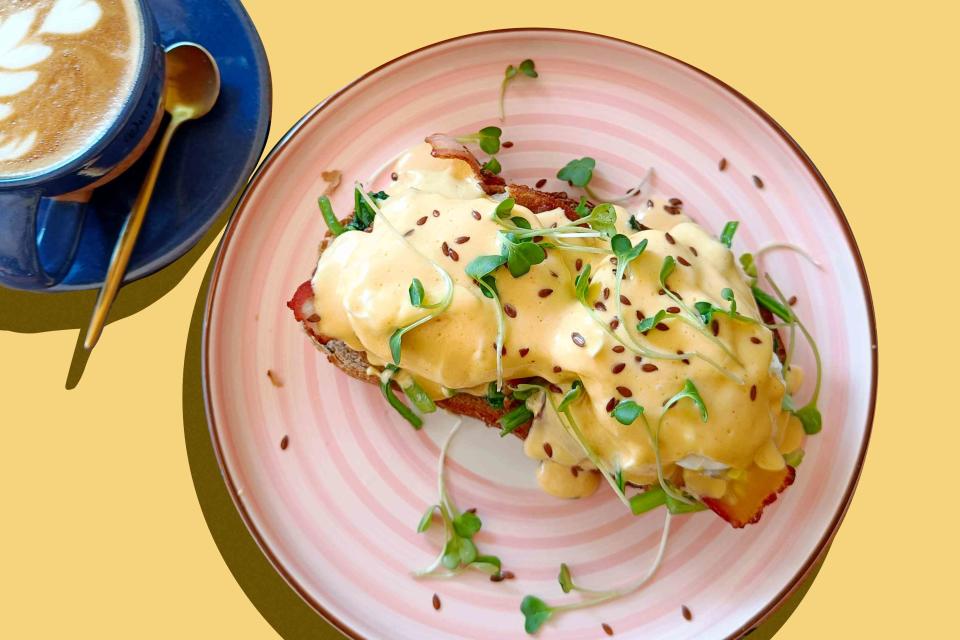What Is Hollandaise Sauce, and How Do You Make It At Home?
Eggs Benedict, here you come!

Carlo A/Getty Images
Hollandaise is one of the five French mother sauces, along with béchamel, velouté, espagnole, and tomato. These sauces are known as the foundation for all other sauces, dubbed daughter sauces (the offspring of the mother sauce) in classic French cooking. Despite its name, Hollandaise doesn’t have anything to do with Holland. It’s very much a classic French sauce, now ubiquitous on American brunch menus.
And like many French foods, Hollandaise is beloved because it’s decadent, creamy, and takes a bit of technique to master. The warm egg yolk and butter emulsion typically seen on dishes like eggs Benedict, offers a rich but neutral flavor, meaning it’s a great base for chefs to add mix-ins or flavors too. This can include anything from fresh herbs to hot sauce, or mustard or brown butter, or really whatever melds in easily with the classic base. Here’s how to start off making Hollandaise.
Related: 5 Ways to Upgrade Your Scrambled Eggs, According to Professional Chefs
What Is Hollandaise Sauce?
Hollandaise is a simple combination of egg yolks, melted butter, and a spritz of lemon juice. It’s creamy, served warm, and a staple over eggs and other proteins.
Hollandaise is notoriously tricky to make and quite temperature sensitive. But, once you nail the recipe, it’s a solid part of any kitchen repertoire.
Chef Ed Cotton of New York’s Jack & Charlie’s 118 recommends making Hollandaise in a double broiler with a wire whisk to ensure the best temperature when emulsifying the ingredients. “If the butter is too hot, you run a risk of breaking this delicate sauce. If the butter is too cold, the sauce will separate when you top your warm poached eggs with it,” Cotton says. It’s essential to not overcook the egg yolks to the point of no return.
“For a newbie making this sauce, be prepared to make a lot of mistakes. You will learn from them,“ Cotton adds. “When the Hollandaise sauce looks or appears to be very thick when you’re adding the butter to the yolks, just adjust the consistency with a little warm water. If you don’t initially thin it out, the Hollandaise sauce will break on you before you have even finished it.”
The good news: Hollandaise can be made in advance of hosting, as long as you keep it at a warm temperature. But practice before inviting guests. “It’s a very temperamental sauce,” Cotton says. “Finding the right spot to store your sauce in the kitchen will take some time.”
Related: 11 Easy, Tasty Breakfast Recipes With Eggs
And once you master Hollandaise, you’ll have a new scope of tools in your culinary repertoire. “You will be able to explore other derivatives,” Cotton notes. “Bearnaise sauce should be the next sauce on your list to make.”
But first, perfect Hollandaise.
Hollandaise Sauce Ingredients
Here’s what you’ll need to make a delicious, rich Hollandaise sauce:
Butter: Butter is the fat that the warm egg yolk emulsifies in, and the most prominent ingredient in Hollandaise. For this reason, you’ll want to use a good quality, European butter.
Egg Yolks: Yolks add the richness to this emulsification. Opt for farm-fresh egg yolks, which are often richer in color and nutrients. Separate out the egg whites and reserve for a different recipe.
Lemon juice: This spritz of acid adds a nice, tangy contrast to the creaminess in Hollandaise. Freshly squeezed lemon juice is best, but bottled can work too. Some chefs also use yuzu juice for extra tartness.
Salt: Using unsalted butter and adding salt to taste ensures you can season your Hollandaise appropriately. Flavored or seasoned salts can also work for a fun twist on the original sauce.
Cayenne pepper: A small pinch of cayenne adds a subtle kick to the Hollandaise. Again, this can be substituted for other types of pepper if you’re riffing on the classic recipe.
Related: 25 Fast, Healthy (and Delicious!) Breakfast Ideas
Hollandaise Sauce Recipe
Now that you know what goes into a classic Hollandaise sauce, here’s how to make it.
Ingredients:
3 egg yolks
1 tablespoon lemon juice, freshly squeezed, if possible
½ cup unsalted butter, melted and still warm
pinch of salt, to taste
pinch of cayenne pepper, to taste
Method:
In a heat-safe bowl (preferably stainless steel), whisk egg yolks and lemon juice together, or blend for 5-10 seconds to incorporate.
Place the bowl over a pot of simmering water on the stove to set up a double boiler, and stream in the melted butter, whisking continuously to emulsify.
Once the sauce is thickened, remove it from heat. Season to taste with salt and cayenne pepper. Serve immediately, or keep it in a warm water bath until you’re ready to enjoy it.
For more Real Simple news, make sure to sign up for our newsletter!
Read the original article on Real Simple.


